Andrew Claxton milks 410 cows alongside his daughter Sarah and son David. They farm over 500 acres in total, with 300 acres at the milking platform.
But the Smarter Milking event last week wasn’t about cows or grass. Indeed, the 200 farmers who attended didn’t even see a cow. This event was all about being leaner and more efficient when it comes to milking cows.
Sarah Claxton explained the milking process. There are always two people milking in the 44-unit GEA herringbone. One milker pre-strips all cows every morning. The other milker attaches the clusters.
“If the person stripping identifies a cow with mastitis, the first thing they do is put the churn [dump bucket] under the cow so the person putting on clusters knows not to milk that cow. They then go into the dairy and write down the date, cow’s number, the date of last treatment, the antibiotic used, when the cow can go into the tank and any other comments on a large whiteboard. After this, they put red straps on the legs and raddle the udder with red paint too. The cow is milked into the churn and the last thing we do is treat the cow with antibiotics.” Sarah said.
The event was organised by Teagasc, FRS and AHI, with support locally from Glanbia. John Fitzgerald from Glanbia said average herd size in Waterford was now 105 cows, which is up 50% in the last five or six years. He said that as herds get bigger, practices need to change as what was OK to do at 60 cows might not be OK at 120 cows.

David Claxton wearing the milking apron with the leg band colour codes printed on it.
Procedures
David Claxton spoke about how they have used standard operating procedures (SOPs) to make the farm more streamlined. He trained and worked as a helicopter pilot for a number of years before returning home to help out on the farm two years ago.
“As a helicopter pilot, we used SOPs for everything. It just means that everyone knows what to do and they all do it the same way so the process is consistent. It’s the same on the farm. We have an SOP for milking, calf rearing and dealing with mastitis. Most farmers have SOPs but they are in their head. Writing them down it’s a better way to communicate with staff and people will learn the right way to do something straight away.
“A relief milker started here two months ago having never milked a cow before. Last weekend that person milked with another relief milker who never milked here before either. They managed perfectly fine and milking times weren’t any longer than if we were doing it ourselves,” David said.
The big parlour has automatic cluster removers. It doesn’t have a dump line but it does have a separate vacuum line which the dump bucket gets vacuum from. Andrew says it takes two hours to milk the 410 cows including wash-up time. They increased the size of the parlour from 29 units to 44 units last winter, reducing the number of rows to be milked from 15 to 9.5. He says cow flow has a big bearing on milking times and operating the air-controlled gates at the right time is key.
“Cows move faster some days than others. We often open the front gate to let off the row when there are still 10 clusters on at the back. Opening the back gate when the cows start to move means the first cow in the next row is in the right position just as the last cow exits so there is no downtime or waiting for the row to fill. We feed some bit of meal all year so we don’t need a backing gate,” Andrew said.

Andrew Claxton, Stradbally, Co Waterford.
Bands
The Claxtons use four different coloured leg bands to identify cows. Cows with a yellow leg band are slow milkers and clusters are attached to these first. Cows with a red leg band are being treated and their milk is to be dumped. Cows with a green band on whichever leg has the front quarter dried off. Cows with a blue leg band have the back quarter dried off. The chart with the different colours are printed on the milking aprons so it’s easy for the milker to see what colour is for what.
The SOPs extend to how to wash the milking machine and what valves to turn and when to turn them. Using sticks, shouting at cows or pinching cows is strictly forbidden and Andrew says they have stopped hiring some relief milkers because they had a habit of shouting at cows to get them to move.
Jim Dockery from FRS spoke about roadways and collecting yards. He said that gaps from paddocks should be at least 5m wide and that the roadways should be 5m wide too. He said collecting yards should be big enough to hold all cows comfortably. Smaller cows need 1.25m square per cow while bigger cows need 1.5m square per cow.
Padraig O’Connor from Teagasc demonstrated best practice at milking. He encouraged farmers to switch hands when attaching clusters to prevent repetitive strain injury. When attaching the clusters on the right-hand side of the parlour facing the front, you should hold the clusters with your left hand and attach cluster in clockwise motion starting at the back left.
When attaching clusters on the left hand side, hold the cluster in your right hand and attach with your left hand starting at the back right and working anti-clockwise. He says now is a good time to learn the correct procedure. He also says that cows get stressed when they are hanging around the collecting yard, so farmers should be ready for milking before they get the cows into the yard.
On milk quality, Jerry Cronin from Glanbia said that a SCC test result above 150,000 indicates a problem.
He suggests that every time a cow gets mastitis, a sample of that milk should be taken, the date and the cow’s number should be recorded on the bottle and it should be put in the freezer. When there are five or six sample bottles they should be sent to the milk lab for a culture and sensitivity test. He said chlorine-free detergents should be used on bulk tanks. It is not a requirement to use chlorine-free detergents in milking parlours.
In short
The Claxton family are milking more than 400 cows and have standard operating procedures for milking, calf rearing and animal health.Colour coded leg bands are used to identify cows with mastitis and dried off quarters.Collecting yards should be a minimum of 1.25m sq per cow.Alternate hands for attaching clusters. Read more
Spotlight on dairy sustainability
Andrew Claxton milks 410 cows alongside his daughter Sarah and son David. They farm over 500 acres in total, with 300 acres at the milking platform.
But the Smarter Milking event last week wasn’t about cows or grass. Indeed, the 200 farmers who attended didn’t even see a cow. This event was all about being leaner and more efficient when it comes to milking cows.
Sarah Claxton explained the milking process. There are always two people milking in the 44-unit GEA herringbone. One milker pre-strips all cows every morning. The other milker attaches the clusters.
“If the person stripping identifies a cow with mastitis, the first thing they do is put the churn [dump bucket] under the cow so the person putting on clusters knows not to milk that cow. They then go into the dairy and write down the date, cow’s number, the date of last treatment, the antibiotic used, when the cow can go into the tank and any other comments on a large whiteboard. After this, they put red straps on the legs and raddle the udder with red paint too. The cow is milked into the churn and the last thing we do is treat the cow with antibiotics.” Sarah said.
The event was organised by Teagasc, FRS and AHI, with support locally from Glanbia. John Fitzgerald from Glanbia said average herd size in Waterford was now 105 cows, which is up 50% in the last five or six years. He said that as herds get bigger, practices need to change as what was OK to do at 60 cows might not be OK at 120 cows.

David Claxton wearing the milking apron with the leg band colour codes printed on it.
Procedures
David Claxton spoke about how they have used standard operating procedures (SOPs) to make the farm more streamlined. He trained and worked as a helicopter pilot for a number of years before returning home to help out on the farm two years ago.
“As a helicopter pilot, we used SOPs for everything. It just means that everyone knows what to do and they all do it the same way so the process is consistent. It’s the same on the farm. We have an SOP for milking, calf rearing and dealing with mastitis. Most farmers have SOPs but they are in their head. Writing them down it’s a better way to communicate with staff and people will learn the right way to do something straight away.
“A relief milker started here two months ago having never milked a cow before. Last weekend that person milked with another relief milker who never milked here before either. They managed perfectly fine and milking times weren’t any longer than if we were doing it ourselves,” David said.
The big parlour has automatic cluster removers. It doesn’t have a dump line but it does have a separate vacuum line which the dump bucket gets vacuum from. Andrew says it takes two hours to milk the 410 cows including wash-up time. They increased the size of the parlour from 29 units to 44 units last winter, reducing the number of rows to be milked from 15 to 9.5. He says cow flow has a big bearing on milking times and operating the air-controlled gates at the right time is key.
“Cows move faster some days than others. We often open the front gate to let off the row when there are still 10 clusters on at the back. Opening the back gate when the cows start to move means the first cow in the next row is in the right position just as the last cow exits so there is no downtime or waiting for the row to fill. We feed some bit of meal all year so we don’t need a backing gate,” Andrew said.

Andrew Claxton, Stradbally, Co Waterford.
Bands
The Claxtons use four different coloured leg bands to identify cows. Cows with a yellow leg band are slow milkers and clusters are attached to these first. Cows with a red leg band are being treated and their milk is to be dumped. Cows with a green band on whichever leg has the front quarter dried off. Cows with a blue leg band have the back quarter dried off. The chart with the different colours are printed on the milking aprons so it’s easy for the milker to see what colour is for what.
The SOPs extend to how to wash the milking machine and what valves to turn and when to turn them. Using sticks, shouting at cows or pinching cows is strictly forbidden and Andrew says they have stopped hiring some relief milkers because they had a habit of shouting at cows to get them to move.
Jim Dockery from FRS spoke about roadways and collecting yards. He said that gaps from paddocks should be at least 5m wide and that the roadways should be 5m wide too. He said collecting yards should be big enough to hold all cows comfortably. Smaller cows need 1.25m square per cow while bigger cows need 1.5m square per cow.
Padraig O’Connor from Teagasc demonstrated best practice at milking. He encouraged farmers to switch hands when attaching clusters to prevent repetitive strain injury. When attaching the clusters on the right-hand side of the parlour facing the front, you should hold the clusters with your left hand and attach cluster in clockwise motion starting at the back left.
When attaching clusters on the left hand side, hold the cluster in your right hand and attach with your left hand starting at the back right and working anti-clockwise. He says now is a good time to learn the correct procedure. He also says that cows get stressed when they are hanging around the collecting yard, so farmers should be ready for milking before they get the cows into the yard.
On milk quality, Jerry Cronin from Glanbia said that a SCC test result above 150,000 indicates a problem.
He suggests that every time a cow gets mastitis, a sample of that milk should be taken, the date and the cow’s number should be recorded on the bottle and it should be put in the freezer. When there are five or six sample bottles they should be sent to the milk lab for a culture and sensitivity test. He said chlorine-free detergents should be used on bulk tanks. It is not a requirement to use chlorine-free detergents in milking parlours.
In short
The Claxton family are milking more than 400 cows and have standard operating procedures for milking, calf rearing and animal health.Colour coded leg bands are used to identify cows with mastitis and dried off quarters.Collecting yards should be a minimum of 1.25m sq per cow.Alternate hands for attaching clusters. Read more
Spotlight on dairy sustainability






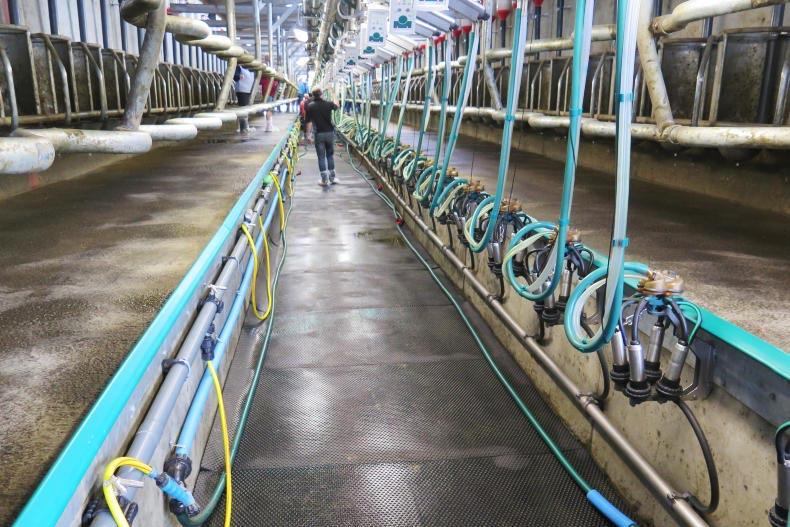
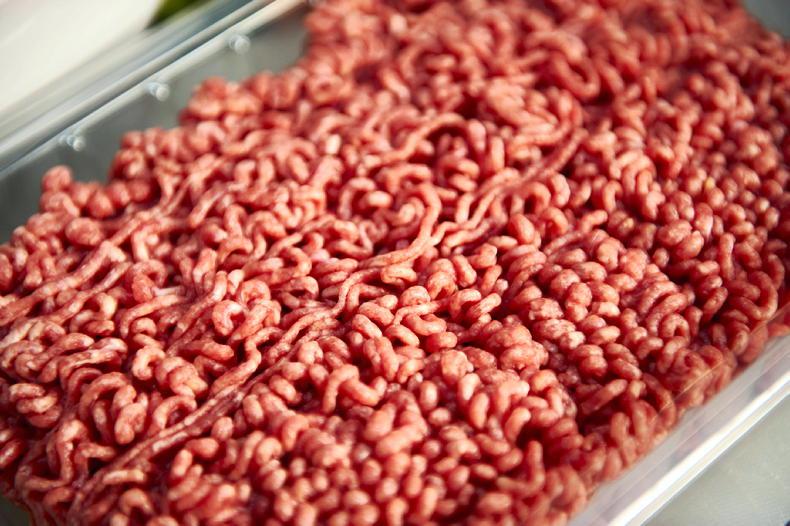

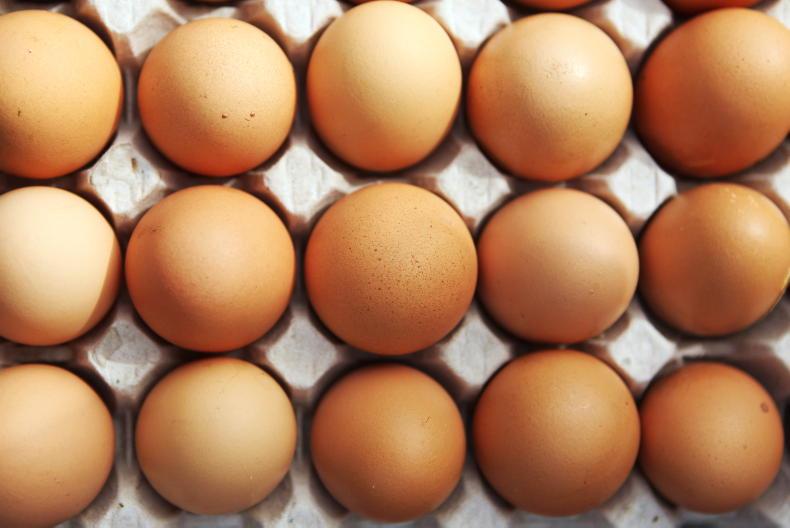
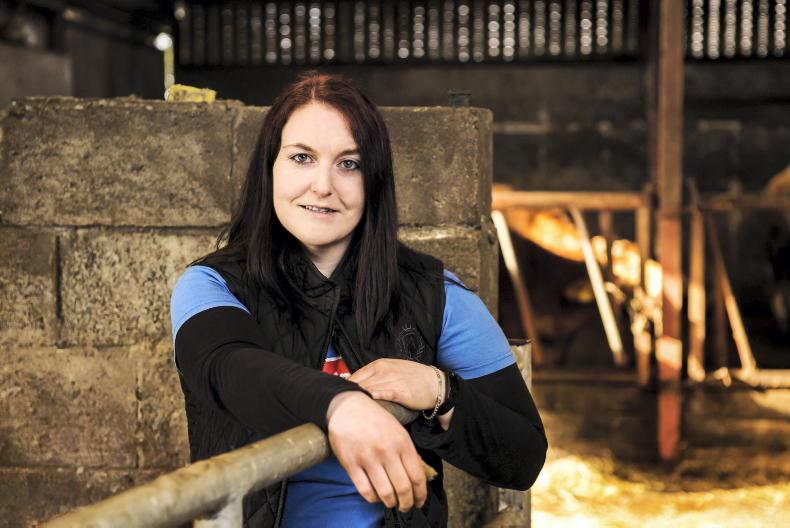
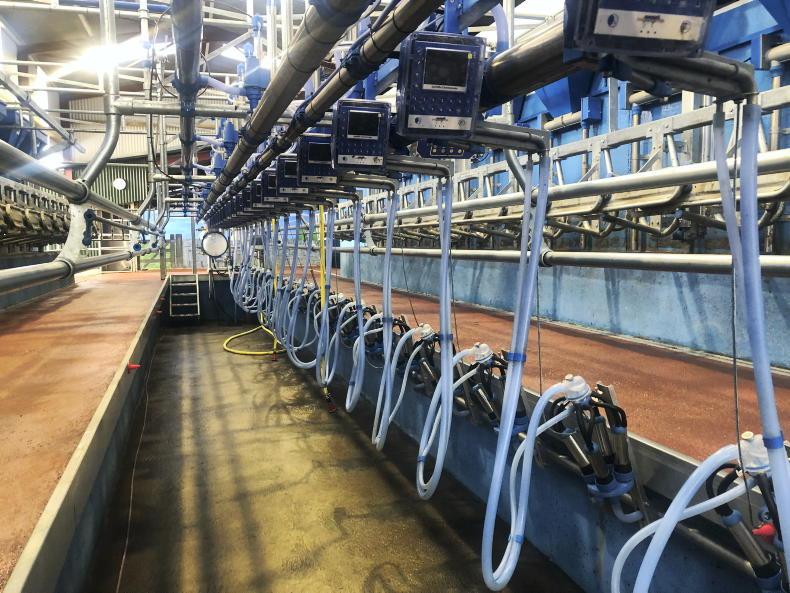
SHARING OPTIONS